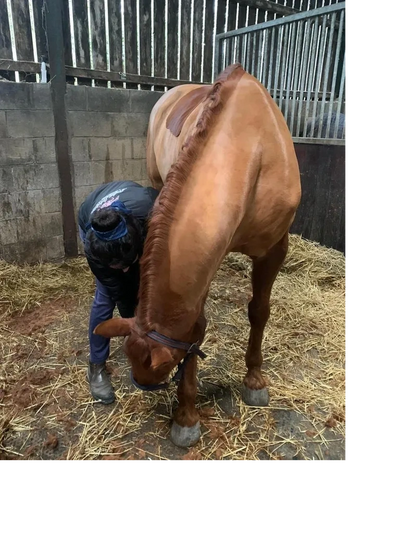What is Equine Sports Therapy?
What is Equine Sports Therapy?
This is a combination of hands-on massage techniques to manipulate the horse’s soft tissues and the carrying out pf passive stretches. Both of these combined with prescribed aftercare exercises for you to carry out can all have huge benefits to the horse in many ways, some of these are as follows:
· Pain relief
· Increased joint mobility.
· Increased range of movement
· Improved proprioception and balance
· Improvement in performance
· Muscle spasm and trigger point release, which left or unrecognised can cause muscular tension, pain and joint inflammation.
· It can help to correctly realign any bones that were being pulled out of place by tightness and tension in the surrounding muscle and soft tissues.
· Reduction of strain on joints
· Promotes relaxation and well-being.
· Relieves tension and stiffness
· Increases flexibility by stretching and relaxing the muscle and soft tissues and encourages it back to its normal relaxed length.
· Promotes quicker removal of waste products and toxins in the muscles- when muscles function, they burn oxygen and glucose and produce lactic acid. This can build up in the muscles and contribute to muscle fatigue and soreness.
· Reduction in the formation of adhesions. Muscles, through wear and tear can develop microscopic tears in the muscle fibres, if not treated these will be replaced by inelastic scar tissue, which is very inflexible. So, manipulation and massaging the muscles helps to reduce their formation.
· Improves muscle tone.
· Increases blood circulation, therefore bringing more oxygen and nutrients into the soft tissues, joints, organs and other bodily systems.
· Effects on the Lymphatic system- Increasing the flow of lymph fluid and so speeding up injury recovery, increasing toxin and bacteria removal through drainage and the reduction of oedema, swellings and excess fluid.
· Effects on Endocrine – release of ‘feel good’ hormones -endorphins.
· Effects on the nervous system – relaxes, calms and it has a soothing effect on tired nerve pathways.
· Effects on respiratory system- Induces deeper breathing by the release of tension on the chest cavity, reduces respiration rate and can help to relieve any build up of mucous congestion.
· Effects on digestive system – Increases peristalsis, releases tension in the abdominal cavity, intestinal muscles and connective tissues, increased circulation and nutrient supply.
· Effects on Integumentary System -Improved coat condition through stimulation of sebaceous glands, improved elasticity and the reduction of scar tissue.
· Effects on joints and bones – Reduces the stress on bones by reducing tension on tendons and ligaments, keeps joints supple through increased circulation, stimulation of synovial fluid and transportation of nutrients.
· Effects on cardiovascular system – Increase circulation so therefore heart function and increases oxygen rich blood supply to the body’s tissues through gaseous exchange in the lungs.
Equine sports therapy is not only used when the horse is having problems, it is also extremely beneficial to have regular maintenance treatments to maintain health and performance, this will not only help to keep the equine athlete in their best possible condition and reducing the chances of injury through maintaining suppleness and elasticity, but will also give your therapist a good understanding of the horses physical condition and so be able to monitor any patterns of soreness and catch any potential problems early before they become too serious.

www.theequinesportstherapist.co.uk
Copyright © 2025 www.theequinesportstherapist.co.uk - All Rights Reserved.